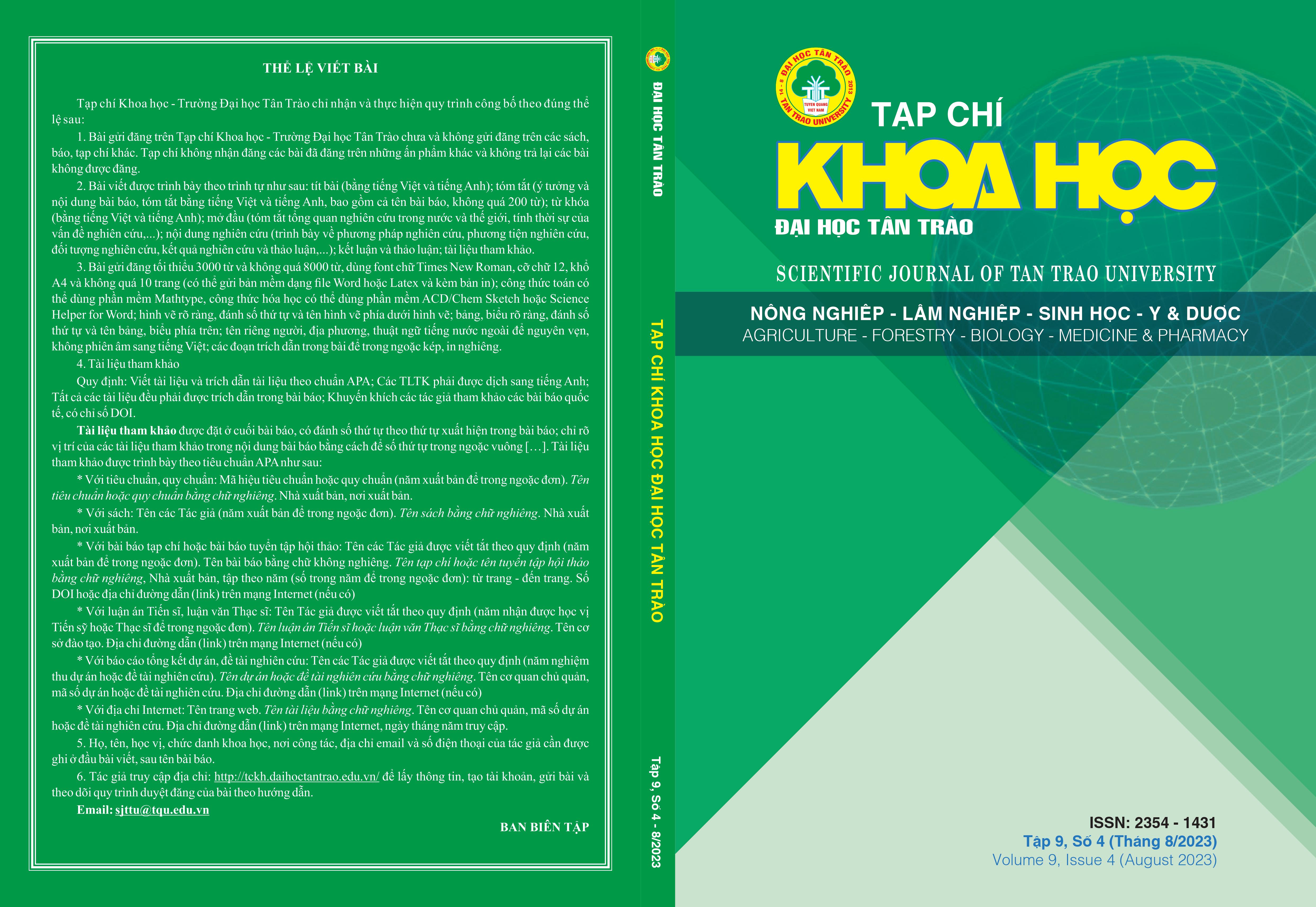NGHIÊN CỨU KHẢ NĂNG NHÂN GIỐNG BẰNG HẠT VÀ SINH TRƯỞNG CỦA CÂY KÌ NAM KIẾN (HYDNOPHYTUM F ORMICARUM JACK.) Ở GIAI ĐOẠN VƯỜN ƯƠM
DOI:
https://doi.org/10.51453/2354-1431/2023/1020Từ khóa:
Kì nam kiến, hydnophytum formicarum jack, nhân giống bằng hạt, Phú QuốcTóm tắt
Nghiên cứu khả năng nhân giống bằng hạt và sinh trưởng của cây kì nam kiến (hydnophytum formicarum jack.) ở giai đoạn vườn ươm được thực hiện tại Vườn Quốc gia Phú Quốc - Kiên Giang. Các kết quả nghiên cứu bước đầu cho thấy, cây kỳ nam kiến có thể nhân giống bằng hạt. Sử dụng hạt lấy từ quả chín có màu cam đậm kết hợp xử lý nước ấm trong thời gian khoảng 30 phút, gieo hạt vào tháng 3 hàng năm, sử dụng che lưới đen 1 lớp và giá thể sơ dừa + rớn (1:1) cho tỷ lệ nảy mầm, tỷ lệ cây sống cao, tỷ lệ hạt thối hỏng thấp, chiều cao cây và số lá/cây cao. Chăm sóc cây con giai đoạn vườn ươm, sử dụng phân bón lá Grow more 30-10-10 + TE (hoặc phân Ryan), tưới nước giữ ẩm giá thể trồng ở mức 75%, và sử dụng giá thể trồng là sơ dừa + rớn (1:1) cho các chỉ tiêu sinh trưởng cây tốt nhất.
Tải xuống
Tài liệu tham khảo
[1] David Darwis, Triana Hertiani, Ediati Samito, The effects of Hydnophytum formicarum ethanolic extract towards lymphocyte, vero and T47d cells proliferation in vitro, Journal of Applied Pharmaceutical Science Vol. 4 (06), pp. 103-109, June, 2014.
[2] Do Huy Bich et al., 2004. Medicinal plants and animals in Vietnam. Volume I, Science and Technology Publishing House.
[3] Do Tat Loi (2004), Medicinal plants and animals in Vietnam, medical publisher, page 436.
[4] Elliot, Rodger W.; Jones, David L.; Blake, Trevor (1990). Encyclopaedia of Australian Plants Suitable for Cultivation: Vol. 5. Port Melbourne: Lothian Press. pp. 392–93. ISBN 0-85091-285-7.
[5] Huxley, C. R. and Jebb, M. H. P. (1991), “The tuberous epiphytes of the Rubiaceae 1: A new subtribe - The Hyd nophytinae. Blumea”, National Botanic Gardens Glasnevin. Dublin, Ireland. 36: 1 – 20.
[6] Karla N. Oliveira, Phyllis D. Coley, Thomas A. Kursar, Lucas A. Kaminski, Marcelo Z. Moreira, and Ricardo I. Campos (2015), “The Effect of Symbiotic Ant Colonies on Plant Growth: A Test Using an Azteca-Cecropia System”, PLoS One, 10(3): e0120351.
[7] Giang Hong Le, Toan Bao Nguyen (2010), “Create callus and regenerate buds from young leaf tissue of Ky nam tree (Hydnophytum formicarum Jack.)”, CTU Journal of Science 2010:16a 216-222.
[8] Royal Botanic Gardens, Kewand Missouri Botanical Garden (2010), “Hydnophytum formicarum”, The Plant List.
[9] Supaluk Prachayasittikul, Prasit Buraparuangsang, Apilak Worachartcheewan, Chartchalerm Isarankura-Na-Ayudhya, Somsak Ruchirawat and Virapong Prachayasittikul (2008), “Antimicrobial and Antioxidative Activities of Bioactive Constituents from Hydnophytum formicarum Jack.”, Molecules, 13(4), 904-921.
[10] Ueda JY, Tezuka Y, Banskota AH, Le Tran Q, Tran QK, Harimaya Y, Saiki I, Kadota S. (2002), “Antiproliferative activity of Vietnamese medicinal plants”, Biol Pharm Bull. 25(6):753-60.
[11] Vivian S.N. et al, 2007, Ant-garden epiphytes are protected against drought in a Venezuelan lowland rain forest ecotropica 13: 93-100, 2007.
Tải xuống
Đã Xuất bản
Cách trích dẫn
Số
Chuyên mục
Giấy phép

Tác phẩm này được cấp phép theo Giấy phép Quốc tế Creative Commons Attribution-ShareAlike 4.0 .
Bài báo được xuất bản ở Tạp chí Khoa học Đại học Tân Trào được cấp phép theo giấy phép Ghi công - Chia sẻ tương tự 4.0 Quốc tế (CC BY-SA). Theo đó, các tác giả khác có thể sao chép, chuyển đổi hay phân phối lại các bài báo này với mục đích hợp pháp trên mọi phương tiện, với điều kiện họ trích dẫn tác giả, Tạp chí Khoa học Đại học Tân Trào và đường link đến bản quyền; nêu rõ các thay đổi đã thực hiện và các nghiên cứu đăng lại được tiến hành theo cùng một bản quyền.
Bản quyền bài báo thuộc về các tác giả, không hạn chế số lượng. Tạp chí Khoa học Tân Trào được cấp giấy phép không độc quyền để xuất bản bài báo với tư cách nhà xuất bản nguồn, kèm theo quyền thương mại để in các bài báo cung cấp cho các thư viện và cá nhân.
Mặc dù các điều khoản của giấy phép CC BY-SA không dành cho các tác giả (với tư cách là người giữ bản quyền của bài báo, họ không bị hạn chế về quyền hạn), khi gửi bài tới Tạp chí Khoa học Đại học Tân Trào, tác giả cần đáp ứng quyền của độc giả, và cần cấp quyền cho bên thứ 3 sử dụng bài báo của họ trong phạm vi của giấy phép.






